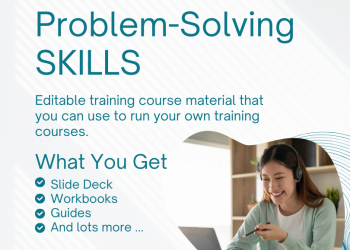You’ve likely heard of the need for “questioning skills” to be successful in your training sessions. In a nutshell, questioning skills are a vehicle that you use to help your delegates learn more in your training session.
This is a short guide to using questioning skills within your training courses.
Feel free to blog, tweet, email, and pass this post to others … but please let people know where you read this guide. Thanks!
Let’s dive in …
Chapter 1: How To Integrate Questioning Skills Within Your Training Courses
Chapter 2: How To Apply Bloom’s Taxonomy To Your Training Courses
Chapter 3: How To Use Simple Questions In Your Training Courses
Chapter 4: Wait Time, Think, Pair & Share
Chapter 5: Alternatives To Questions
Chapter 6: Online Tools You Can Use
Let’s dive right in.
Chapter 1: How To Integrate Questioning Skills Within Your Training Sessions
Given my long background in learning and development, I knew my purpose in these posts would be to share my experience and benefit others, such as managers and training professionals.
In this section, I’ll answer, ” How should you integrate questioning skills into your training sessions?”
I’ll also show why questioning skills are crucial for training professionals and managers.
In particular, what are questioning skills, and what should they be used for?
Let’s get started.
The use of questions within training sessions
Start by asking yourself a question. What are questioning skills, and what should they be used for?
If you don’t know the answer instantly, don’t worry. Often, the things we do daily and take for granted can be the hardest to explain.
You might be surprised to hear that using questions in training sessions to improve learning is nothing new; it dates back to the Socratic method of Ancient Greece.
Let’s dig a little deeper …
According to Benjamin Bloom and his colleagues, there are six levels of cognition:
Knowledge: rote memorization, recognition, or recall of facts
Comprehension: understanding what the facts mean
Application: correct use of the facts, rules, or ideas
Analysis: breaking down information into parts
Synthesis: a combination of facts, ideas, or information to make a new whole
Evaluation: judging or forming an opinion about the information or situation
Chapter 2: How to apply Bloom’s taxonomy to your training sessions
Ideally, each level should be covered in each course, and at least one objective should be written for each level.
Depending on the nature of the training course you are delivering, some of these levels may require more emphasis than others.
To help you prepare for any training course, I have provided examples below of objectives written for each level of Bloom’s Taxonomy and activities and assessment tools based on those objectives.
For your convenience, common key verbs used in drafting objectives are also listed for each level.
Level: Knowledge
Level Attributes: Rote memorization, recognition, or recall of facts.
Keywords: list, recite, define, name, match, quote, recall, show, identify, label, recognize.
Example Objective: “At the end of this course, participants will be able to define problem-solving”.
Example Activity: Have participants list different definitions of problem-solving. Example Assessment: Use the following question on an exam or homework. “what is problem-solving?”
Level: Comprehension
Level Attributes: Understanding what the facts mean.
Keywords: describe, explain, paraphrase, restate, interpret, paraphrase, differentiate, summarize, analyse, discuss, compare.
Example Objective: “At the end of this course, the participants will be able to differentiate between two types of problems”
Example Activity: Group participants into pairs and have each pair think of different problems they could experience in a work environment.
Example Assessment: Assign the participants to write a simple description of different types of problems
Level: Application
Level Attributes: Correct use of the facts, rules, or ideas.
Keywords: calculate, predict, apply, solve, illustrate, use, relate, modify, demonstrate, determine, model.
Example Objective: “At the end of this course, the participants will be able to complete a force field analysis of a named problem situation”.
Example Activity: After presenting the different problem-solving techniques, have participants form pairs and complete a force-field analysis.
Example Assessment: On a test, define a force-field analysis.
Level: Analysis
Level Attributes: Breaking down information into parts.
Keywords: classify, outline, break down, categorize, analyze, organize, contrast, deduce, discuss, plan, diagram, illustrate.
Example Objective: “At the end of this course, the participants will be able to contrast cause and effect diagrams and a SWOT Analysis”
Example Activity: Present the participants with different problem-solving techniques and then have them explain in detail the differences between a cause-and-effect diagram and a SWOT Analysis.
Example Assessment: Give the participants an assignment that asks them to explain in detail the differences between a cause-and-effect diagram and a SWOT Analysis.
Level: Synthesis
Level Attributes: Combining parts to make a new whole.
Keywords: design, formulate, build, invent, create, compose, generate, derive, justify, modify, report, develop.
Example Objective: At the end of this course section, the participant can create a personal model for effective problem-solving within a large manufacturing setting”.
Example Activity: Discuss the underlying similarities between different problem-solving approaches regardless of where the problem occurs.
Example Assessment: Give the participants a project to create a personal model for effective problem-solving in a large manufacturing setting.
Level: Evaluation
Level Attributes: Using questioning skills to judge the value or worth of information or ideas.
Keywords: choose, support, relate, evaluate, determine, criticize, defend, judge, grade, compare, contrast, argue, justify, support, convince, select, evaluate.
Example Objective: “At the end of the course, the participant will be able to determine what problem-solving technique suits their work environment”.
Example Activity: Have different groups of participants solve the same problem using various methods, then have each group present the pros and cons of the chosen method.
Example Assessment: On a test, ask participants to describe in detail which problem-solving technique best suits their work environment and why.
Chapter 3: How To Use Simple Questions In Your Training Courses
Learning is an active process.
Trainers must encourage participants to think independently and construct their explanations. This will allow participants to maximize their learning potential.
Ask participants to seek the evidence: What kind of evidence did you find? What makes you think that…?
Ask participants to explain: How would you describe this? What were some of the causes that led to…?
Ask questions that relate to concepts, ideas, and opinions: How does that compare to…? What did other people discover or say about …?
Ask questions encouraging your participants to predict: What will you do next? What will happen if you…? What could you do to prevent that?
Wait Time
One of the most effective techniques used in conjunction with questions is known as ‘wait-time’. This is the length of time that is left between asking the question and looking for the answer. In most training sessions, the wait time is 1-2 seconds. If no reply is received by this time, the trainer will usually intervene with the answer or with more vital prompts. Research shows that waiting longer than 3 seconds will result in better answers and increased motivation for the participant.
Think, Pair & Share
For more challenging questions, ask participants to take some time to think of the answer. Ask them to then pair with the person next to them and share their answers with the larger. This allows for a different type of ‘wait time’ and strengthens the learning process available to the whole group.
Chapter 5: Alternatives To Using Questions
One of the points I want to stress in this free guide is that there are alternatives to using questions and that these alternatives are the essential secrets to delivery success.
Below, I offer some simple examples highlighting the purpose (e.g., invite delegates to elaborate) and example invitations.
Purpose: Invite delegates to elaborate.
Example: ‘Would you say a little more about that.’ ‘I am not sure I know what you mean by that.’
Purpose: Speculate about the subject under discussion.
Example: ‘I wonder what might happen if …’
Purpose: Make a suggestion.
Example: ‘You could try …’
Purpose: Reflect on the topic. Perhaps we now have a way of tackling this next time.
Example: ‘Let’s bring this all together …’
Purpose: Offer extra information.
Example: ‘It might be useful to know also that … ‘I think I have read that …’
Purpose: Reinforce valuable suggestions.
Example: ‘I especially liked … because …’
Purpose: Clarify ideas.
Example: ‘We can tell this is the case by …’
Purpose: Correct me if I’m wrong.
Example: ‘But I thought we had agreed that …’ ‘So now perhaps we all believe …’
Purpose: Echo comments/summarise.
Example: ‘So, you think …” Jane seems to be saying …’.
Purpose: Non-verbal interventions.
Example: Make eye contact, nod, or raise eyebrows to encourage extended responses, challenge, or even express surprise.
Chapter 6: Online Tools You Can Use
To conclude, here is a quick list of some online tools you can use to practice your questioning skills. Please note we are not affiliated with any of these providers, and the list is provided for your convenience.
Keynote – Keynote makes creating stunning and memorable presentations easy and includes most Apple devices.
Prezi – Unlike screen sharing, Prezi Video lets you interact with your visuals on screen.
LinkedIn SlideShare – Share what you know and love through presentations, infographics, documents, and more.
Zoho Show – Bring your team to a secure and collaborative workspace where everything is available to everyone in real-time. Create, collaborate, and get work done securely.
FlowVella – Blow your audience away in one interactive presentation experience.
LibreOffice Impress – LibreOffice is a free and powerful office suite and a successor to OpenOffice.org (commonly known as OpenOffice). Its clean interface and feature-rich tools help unleash creativity and enhance productivity.
Ludus – collaborative presentations for creative teams.The presentation tool that combines creativity with simplicity… and a bit of magic.
PowToon—Powtoon is a visual communication platform that allows you to create professional, fully customized videos that your audience will love.
Speaker Deck – Turning your decks into beautiful online experiences can be painful.
Visme – Create visual brand experiences for your business whether you are a seasoned designer or a total novice.
WPS Presentation – free and complete office suite.
authorSTREAM – the best way to share presentations on the web.
Genially – Create presentations, infographics, and other stunning content with your team.
Canva—With thousands of professional templates, images, and quality content to choose from, you can get a headstart on bringing your best ideas to life.
Beautiful.ai – It’s an expert deck designer, so you don’t have to be. Make your business look brilliant, keep your team forever on brand, and save hours on pitches you’re proud of.
Ahaslides—Create interactive presentations for awestruck audiences. It is the perfect tool for lessons, training, meetings, and quizzes.
Conclusion
That’s it for our guide to questioning skills in your training courses.
And please don’t forget to share this guide.
The World’s Best Brands Trust Oak Innovation
With 30+ years of training experience, I founded Oak Innovation (oakinnovation.com) in 1995. I help busy training professionals and business managers deliver better training courses in less time by giving them instant access to editable training course material. I received my Bachelor’s and Master’s degrees from University College Cork. I hold qualifications in Professional Development And Training from University College Galway. Clients include Apple, Time Warner, and Harvard University.





















































